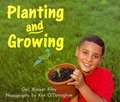- Table View
- List View
More NIMAC books are available at www.nimac.us. If you find your title in the NIMAC and not in Bookshare then please contact us to request it.
Picture Cards, Grade K (Into Reading, Read Aloud Module 10)
by Houghton Mifflin Harcourt Publishing CompanyNIMAC-sourced textbook
El pingüino emperador (¡Arriba la Lectura! , Level I #9)
by Elsie NelleyEl pingüino emperador vive en lugares muy fríos. Con tanto hielo y tanta nieve a su alrededor, ¡podríamos pensar que el pingüino emperador siempre tiene frío! ¿Qué trucos tiene el pingüino emperador para mantenerse caliente? NIMAC-sourced textbook
Pink Lakes and Other Shocking Sights (Fountas & Pinnell Classroom, Guided Reading Grade 4)
by Carmen MoraisNIMAC-sourced textbook
Pistas del pasado (¡Arriba la Lectura!, Level R #9)
by Cynthia Mercati Jared OsterholdNIMAC-sourced textbook
Placebos: Fake Medicine, Real Results (Fountas & Pinnell Classroom, Guided Reading)
by Tom CostaNIMAC-sourced textbook
Un planeta a energía solar (¡Arriba la Lectura! Level U #59)
by Jill McDougall Bill WoodNIMAC-sourced textbook
Planetas en movimiento (¡Arriba la Lectura!, Level N #5)
by Jillian Powell Sean O'NeillNIMAC-sourced textbook
Plant Man: The Life and Art of Makoto Azuma (Fountas & Pinnell Classroom, Guided Reading Grade 6)
by Nicole WalkerFrom Guitars to FLOWERS When a young rock musician struggled to pay his bills, he was forced to take a job doing something he never thought he'd do: work in a flower shop. But that fateful turn of events changed Makoto Azuma's life forever. His job soon evolved into a passion for transforming flowers into art. Now, his amazing and outrageous artwork never fails to surprise and delight audiences around the world. NIMAC-sourced textbook
Plant Signals: How and Why Plants Communicate (Fountas & Pinnell Classroom, Guided Reading Grade 6)
by Corey FlanniganMysterious Communications When hiking in a forest, we admire a redwood's beauty or a pine tree's fragrance. But what we don't notice are the trees' hidden talents. Trees and other plants can actually communicate with one another in surprising ways—and for fascinating reasons. NIMAC-sourced textbook
Plantas carnívoras: Plantas que comen insectos (¡Arriba la Lectura!, Level O #14)
by Katie SharpNIMAC-sourced textbook
Las plantas necesitan agua (¡Arriba la Lectura!, Level K #43)
by Heather HammondsTanto los humanos como los animales dependen de las plantas para alimentarse. Por eso, es importante que las plantas reciban suficiente agua. ¿Cómo obtienen las plantas el agua que necesitan para sobrevivir? NIMAC-sourced textbook
Las plantas que usamos (¡Arriba la Lectura!, Level K #89)
by Lisa ShulmanNIMAC-sourced textbook. Las plantas se usan para hacer libros, ropa y muchas otras cosas. Descubre qué partes de las plantas se usan para hacer las cosas que necesitamos.
Las plantas y el sol (¡Arriba la Lectura!, Leveled Reader Benchmark K-2, Level K #11)
by Thea Franklin Margo BurianNIMAC-sourced textbook
Planting and Growing (Into Reading, Level E #26)
by Ken O'Donoghue Gail RileyNIMAC-sourced textbook
Plants We Use (Into Reading, Level K #89)
by Lisa ShulmanWe use plants to make books, clothing, and other things. Find out how we use different parts of plants to make the things we need.
Plastic Eaters: Wax Worms on the Job (Fountas & Pinnell Classroom, Guided Reading Grade 6)
by Catherine JohnWorms Hold the Key Plastic is piling up everywhere, clogging landfills and oceans. Even as people around the globe recycle and reuse plastic, the problem persists. But scientists may have discovered a solution: WORMS! Yes, wax worms may hold the key to solving our plastic problem. Read on to discover why scientists are so excited about these white wiggly worms. NIMAC-sourced textbook
Plásticos: ¿Son buenos o malos? (¡Arriba la Lectura!, Level S #16)
by Phillip SimpsonNIMAC-sourced textbook

